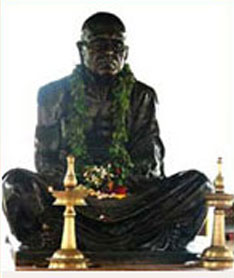Thalassery has a very rich visual arts history. It was the center of chirakkal, kottayam and Kadathanad Kings and was also a center of education which contributed to its evolution as arts and sculpture center. Dr. M.D. Raghavan has written about the Chellath cave paintings at Punnol in Thalassery. Most of the paintings do not exist now. But their remains indicate the rich cultrual heritage of Kerala.
The wall painitings on the Thiruvangad Vadakedam Temple show that Kerala had a history of nural paintings also. Interestingly this was a period when people like artists were not allowed into the temple. One of the most striking examples of Keralas artistic history are the paintings on the Thiruvangad temple walls.
These creations were done by the Perunthachans whose artistic abilities are visible on the doors and prayer halls of the Thiruvangad temple. This is also visible in the Odathil mosque. The parashuram idol in the Thrukkai Shiva Temple is also a example of artistic excels. The ability of the Pariyaram artists is also evident in the idol installed by Shri Narayana Guru at the Jaganatha Temple.
The colours of these idols were decided by Shir Raman who later established the Cochin School of Arts. He was also the inspiration for C.V. Balan Nair who Thalassery can never forget. Balan Nair set up 'The Kerala School of Arts' which is now functioning on 27 cents of land at Manjodi in Thalassery. Another great artist from Thalassery was M.P. Achuthan Master who was the teacher at BEMP High School. Another great contribution of Thalassery was Sanjayan who mermerised people with his humour and writing.
The Kottayam Thamburan who scaled new heights in Kathakali had Thalassery as a stage.
Thalassery has nothing much to boast of a culture of paintings. The Konkani and Tamil families settled in Thalassery, used to draw kolangal at their homes as a sign for welcoming the god of prosperity. However, ritualistic powder paintings were prevalent in and around Thalassery even in the earlier days. There used to be drawings with five coloured powder at the Thiruvangad Sri Rama swamy temple and at the Koormba Kavu as part of their rituals. At the Thiruvangad temple powder paintings are drawn by ‘Karuppans’ as part of the theyyambadi dances (Sri Kottath Krishnan Nambiar is the famous person of the North for the powder paintings). There were a class of skilled persons called ‘kidarans’ at Thalassery who were experts in painting the wooden carvings with natural colours. Nobody working in that field is available in thalassery these days.
Thalassery was a good platform for the visual and folk arts like ‘Theyyam’, ‘Thira’, ‘Nina bali’, ‘Malayan Kettu’ and classical visual art forms like ‘Kathakali’ and ‘Chakyar koothu’. Thalassery could bring the art form ‘Kathakali’ down to the masses which was traditionally the art form of upper classes. The history has blessed Thalassery with a great culture of visual art.
The Mavilai kavu Adiulsavam is seen only in Thalassery. It is celebrated in the month of Malayalam month 'Medam' (April). The festival is also a time when families get together. The Daivatar are the main god of this festival. The new deity was installed in Makara month (Malayalam) in 1092 when the Mavila kavu temple was renovated. The Adi takes place on Medam 2 and 4. The elder member of the Valiaveetil selects those who are participating in this festival.
The festival can be traced back to a time when the Daivatar used to visit the kacherikavil temple. At this time two nambiar brothers were also used to visit the temple. The Namboodiri of the illam who was carrying the rice threw it among the two brothers and asked them to fight for it. The brothers started beating each other. When Daivatar saw this he intervened and stop the beating. This is the legend behind the festival. People come from various parts of Kerala to see this beating festival where the kaikollanmar after undertaking a fast, fight with each other standing on shoulders.
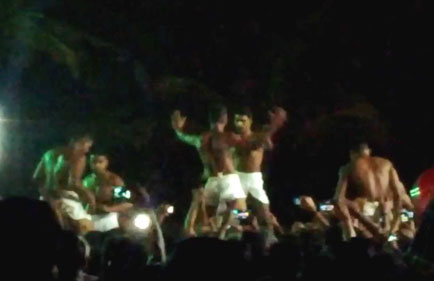
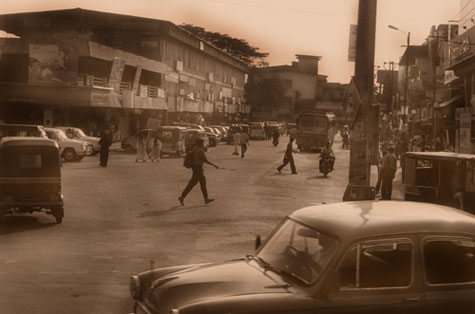
The beautiful Sharada Krishna Iyer Auditorium in the heart of Thalassery finally became a reality. It would be worthwhile to recall some of the meories associated with Sharada Krishna Iyer. The legendary justice Krisna Iyer also belongs to Thalassery. In the 50's and 60's communal harmony was a reality in Thalassery. There was no need of any meetings or oath taking ceremonies to strengthen communal harmony
The dramas of KPSC and progressive writers played a big role in spreading harmony. The presence of legendary singers like Mohammed Rafi, Talat Mahammood, S. Janaki, Yesudas also helped in spreading this culture of harmony. Mohammed Rafi and Talat Mahammood visited Thalassery twice during this period. Vaijayanthimala danced at the B.E.M.P. High School ground in 1949. Those who came and made speeches here in 1950's include Jawaharlal Nehru, Dange, Ramamurthy, A.K.G, A.Ahamed and others. Others who came here and spoke were E.M.S. Namboodiripad, Hiren Mukerjee, Ashoka Mehta and Dr. Rammanohar Lohia.
The literacy society started by Prof. M.S. Menon and M.N. Vijayan conducted a lot of literary programmes which was hugely successful.
‘Kalari’s were the places of education in ancient Kerala where mainly martial arts and physical training was imparted to the children. The practice in those days was to enrol children for the ‘Kalari’, once they completed their elementary education.
For learning Kalari payattu, the martial art, there were no sex differences. Both girls and boys were enrolled. The kalari payattu can be completed only after a continuous and strenuous practice of over five years.
The famous historic duel between Kathiroor Gurukkal and Thacholi Othenan took place at Ezhara kandam in Ponnyam.
The unconquerable Kathiroor Gurukkal was defeated and killed by Othenan using ‘poozhikadakan’ considered an unethical move as per the tenets of martial arts code. The famous ‘thacholi vadakkan’ songs describes that Othenan was later shot and killed by Kathiroor Gurukkal’s desciple, Chundangapoyil Mayan Kutty, when Othenan came back to the place of duel to take back his weapons which he had forgotten before leaving.
We can see the influence of Kalarippayattu in all the traditional visual art forms in Kerala including ‘Koothu’, ‘Koodiyattam’, ‘Kathakali’, ‘Velakkali’ and ‘Kolkkali’. It is also believed that Kerala got its prominence in Circus because of the practice of the practice of ‘Kalari’ in these areas.
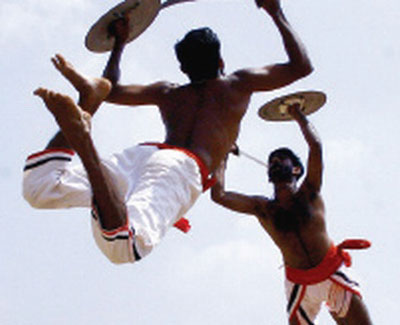
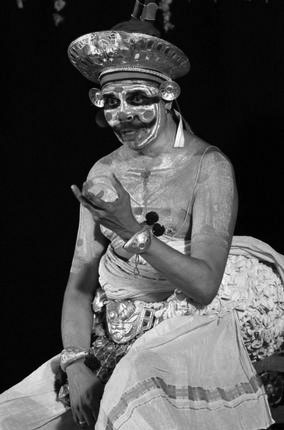
Koothu was popularised by the Kottayam King and later reached North Kerala. This dance form exists at several temples but has not yet gained popularity. The dance form presented by the Chakyar community with music is called chakyar koothu. It is still presented at the Kottiyur Temple during the Vaishakha festival. No serious effort has been made till now to go to the roots of koothu.
The Koothambalam set up by the Kootayam King to popularise Art forms near the Mahadeva Temple became the main platform for such dances. In this dance form the Chakyar arrives with a painted face with a traditional lamp lit to mark his performance. Today the Irrigation Project Office and a Co-operative Union office stand at the place where Kuthu parambu once existed and there are no koothu performers now. It is seen only in school festival competitions. The Kottayam royal family still does a lot for Koothu with Pazhazhi Shankara Varma being an excellent musician.
The Thalassery Srirama Swamy Temple has seen Koothu performances from ancient times. A musical instrument used for this performances is still present in the temple premises.
Muslim Reforms started in Thalassery a long back ago. This town has initiated great challenges in the Muslim community and continues to do so. The Eid prayer started for the first time in kerala in Thalassery. Mass prayers were conducted on Eid-ul-fitr and Eid-ul-zuha for which the Eidgah Committee did a lot of work. Former district judge Mir Sainuddin, Educational expert C.O.D. Kunjupakki, Police Superintendent Kalimullah and others co-operated with Eidgah committee.
These festival activities were followed by mass public meetings in the evenings. It was Makki Sahib who took the lead in organising the mass prayer on festival days in an open place. A small book on the history of Eidgah was kept carefully by Makki Sahib.
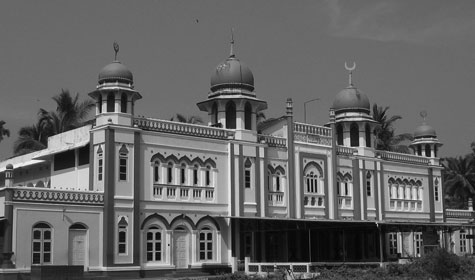
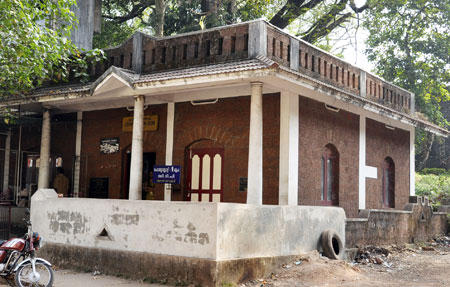
Located on Gundert Road, near Thalassery fort, the library is an oft-frequented place by booklovers, young and old alike, in and around Thalassery. The library has nearly 60 life members and above 3,200 ‘A’ class members. Teachers and researchers also form part of its regular visitors.
The library, named after Queen Victoria in its initial days by the British, was rechristened after Maulana Abul Kalam Azad post-Independence. The then cultural and literary stalwarts in the town, including Sanjayan, Moorkoth Kumaran, O. Chandumenon and Supreme Court judge V.R. Krishna Iyer, were instrumental in developing the library.
The building was reconstructed in 2005, braving stiff resistance of the Archaeological Survey of India for putting up a construction in the vicinity to the fort.
Malayala Kalagramam is a centre for art and ideas which aims at providing children and youngsters a Kalari (stage) to practise and perform all forms of fine arts. The centre offers part time as well as full time courses in painting, sculpture, music and dance and art pottery. Yoga and Sanskrit are also taught here. The fraternity centre of the Kalagramam conducts seminars, symposia, extension lectures, in-service programmes and special projects in different fields of art and humanities.
Spending a day here with the tutors, students and the exotic library is an enlightening experience for any art lover. It is located at New Mahe which is about 8 Km away from Thalassery Town.
Official Website : http://www.kalagramam.org
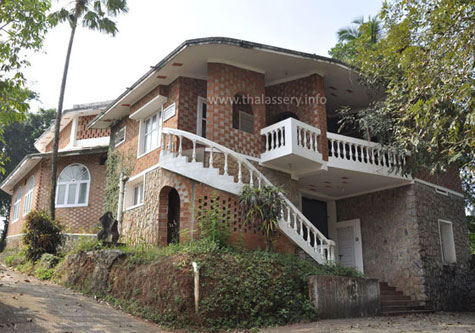
Thalassery has got an ancient visual art tradition. Thalassery which got its importance as a centre for Chirakkal, Kottayam and Kadathanad Kingdoms and as an educational centre can claim, even though it cannot be claimed as highly rich but a notable tradition, of painting and sculpture.
In his research on the ancient civilization of Kerala, Dr. M.D.Ragavan has recorded about the cave paintings at Chellath near Punnol in Thalassery. Those caves no longer exist today. However the findings from those caves regarding the use of Red and Black based colour combinations has got an important place in the Art history of Kerala.
The collection of paintings at Thodikulam, Mattannur and Pariyaram belonging to the Kottayam Rajas and paintings at Kuttippuram, Purameri, Kaliyamvalli belonging to the Kadathanad Rajas etc. can be treated as part of the chain of Artistic history of Thalassery. At the vadakkedam temple of Thiruvangad, there were beautiful ancient mural paintings belonging to the Kerala School of Mural Art. In the renovation of the temple taken up a few years back even the remaining paintings were lost. With the available evidence it could be concluded that even in the walls of Sree Rama Temple at Thiruvangad there were ancient mural paintings.
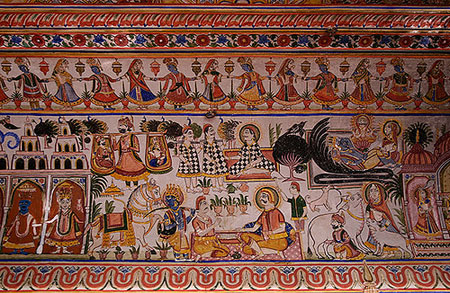
Some live Mural Paintings blossomed out of the minds of ancient Artists who had no right to enter the temples on those days, can be seen at the walls of Muzhappilangad Bagavathi Temple. These local paintings experts were the followers of the Kerala School of Mural paintings in their themes and outlook.
The wood carvings at the ‘Balikkal Mandap’ in Jagannath Temple, a temple consecrated by Sree Narayana Guru, are an excellent testimony to the skills of Pariyaram sculptures. The colour designs of these sculptures were done by Sreeraman, famous artist and founder of Cochin Arts School. These colour designs have directly or indirectly has taken part in the contemporary artistic styles of Thalassery.
In line with the European practices, the Christian Churches in Thalassery adorns European model goddess sculptures and stained glass paintings. The colour glass painting at the Protestant Church, which was constructed in 1869 by Lord Napier near Thalassery Fort, is very beautiful. Such art works could be seen in many Muslim Houses and serves as a memorial for our trade relations with the Europe in those days.
Sarada Krishna Iyer Memorial Fine Arts Society is a Society registered in 1975 to provide a permanent platform for social and cultural activities in Thalassery. Named after the late Sarada Krishna Iyer, wife of V.R. Krishna Iyer, the Society is also a memorial for the selfless and silent service rendered by this towering personality in the fields of arts, literature, sports and also in public services, service to the destitute and other humanitarian services.
The Society was inaugurated by former Chief Minister of West Bengal, late Shri. Siddarth Sankar Ray. The foundation stone for the Sarada Krishnaira memorial Auditorium, an initiative of the Society, was laid by the then President, Sri. B.D. Jatti, in Thalassery in the land allotted by Government of Kerala.
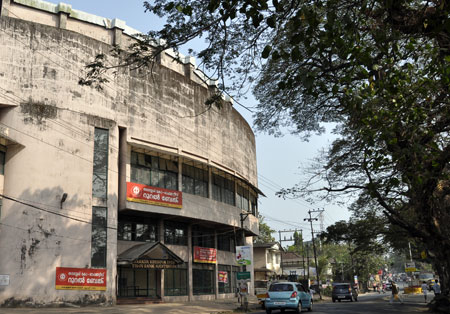
The stated objectives of the Society include promotion of the Fine Arts and Fork Arts, conduct of seminars on contemporary issues, organisation of programmes on classical music, dance, drama and other art forms.
The establishment of Sharada Mandir is the beginning of a cultural revolution in Thalassery. As old times know Thalassery evolved as a place for import and export of goods and the British made it as their commercial centrer in North Malabar. If this situation had continued, Thalassery would have become a major industrial city of Kerala. Unfortunately after Kerala was formed Malabar was divided into three districts and Kannur became the center of the Northern district. This was a big blow for Thalassery which remained a commercial center. The commercial activity in Thalassery is characterised by strong ties between merchants. Commercial transactions happened because of this faith in each other.
A part of the profit from this commercial activity used to be spent on cultural programmes. In recent years such relationships in Thalassery have been spoilt. Cultural activity and commercial activity are strongly interlinked. The cultural revolution is now needed in Thalassery.
C.V. Balan Nair who was an expert in painting and kalaripayattu, established Kerala School of Arts in 1933. This Art School was the cornerstone of the contemporary artistic tradition of North Kerala. He spent his whole life for the painting art. Kerala Sahitya Academy recognised his work with a honorary membership. The Kerala School of Arts now stands as a memorial for his work. In 1957 after Kerala state was formed students were sent for the KGTE and KCE drawing and painting examinations. This school helped a lot artists sharpen their skills and work in India and abroad.
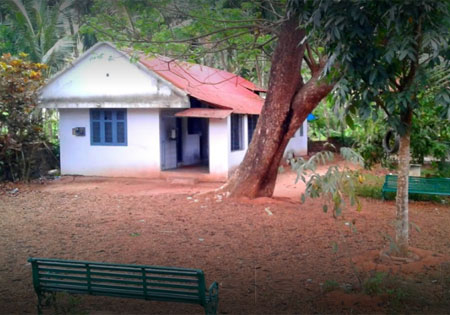
The school is located now at Manjodi in Thalassery in a 27 cent land allocated by the Thalassery Municipality. This School have contributed several nationally acclaimed and famous painting artists. This was built with the contributions of the School Alumni. Today teachers including A.V. Venugopal, Sathyanathan and A.V. Vijayan are teaching besides the Principal. The course is of 5 years duration. A committee formed under the charitable society's act governs the school and was headed by Shri M.B. Nair at the beginning.
Address:
The School of Fine Arts
P.O. Chirakkara
Thalassery - 670 104
Kerala
Telephone : 0490 - 2322814
The first full body statue of Sree Naryana Guru was put up in Thalassery. This was unveiled at the premises of Sri Jagannath Temple even when Sree Narayana Guru was alive. This was sculpted at Italy and is a great model of metallic sculpture and technology.
The half bodied statue of Mahatma Gandhi installed at Thalassery Municipal Office premises was designed by famous sculptor Roy Chowdary. This statue was also casted in Italy.In June 2010, Gundert Statue was installed near Thalassery Municipal Stadium to honour him.
Two skilled sculptors of Thalassery were N. Kumaran Master who was a teacher in Government High School and Chippies Gopalan from Temple Gate, Thalassery. N. Koyithatta who has written several books on Indian architecture and Indian Scultpure should also be remembered here.
